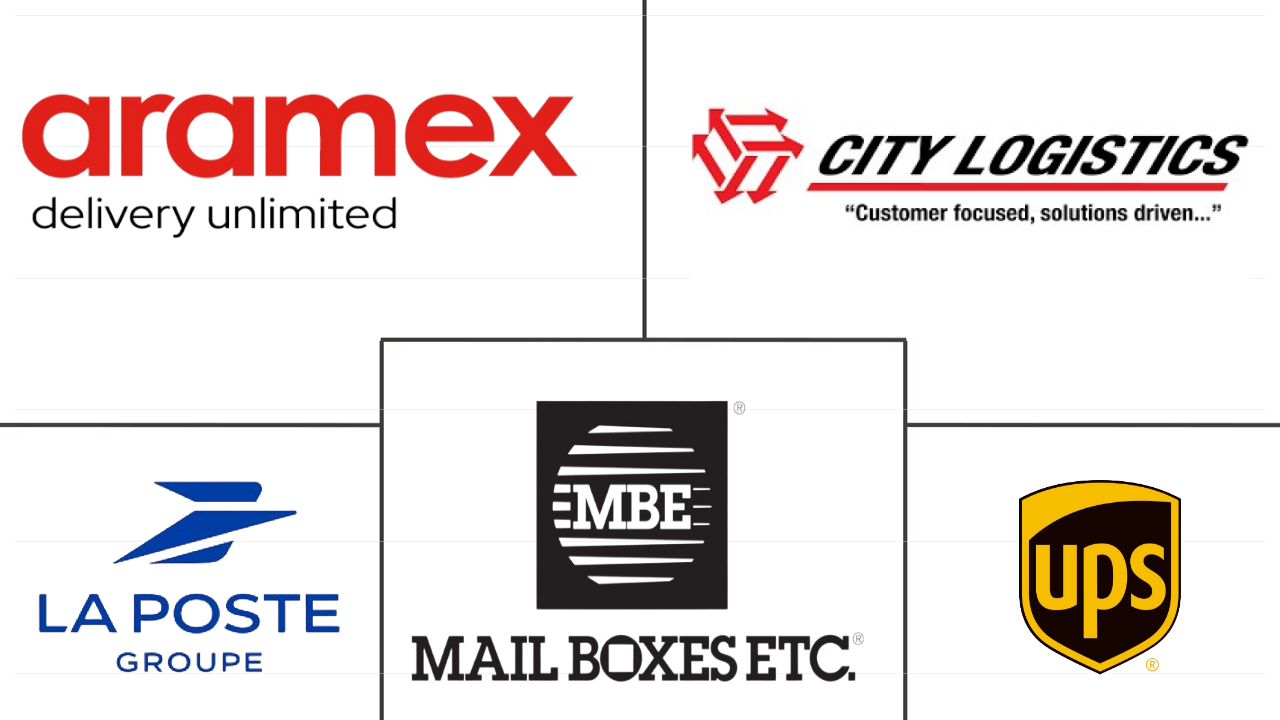Market Size of south africa courier, express, and parcel (cep) Industry
| Icons | Lable | Value |
|---|---|---|
|
|
Study Period | 2017 - 2030 |
|
|
Market Size (2024) | USD 207.96 Million |
|
|
Market Size (2030) | USD 316.28 Million |
|
|
Largest Share by Destination | Domestic |
|
|
CAGR (2024 - 2030) | 7.24 % |
|
|
Fastest Growing by Destination | International |
|
|
Market Concentration | Medium |
Major Players |
||

|
||
|
*Disclaimer: Major Players sorted in no particular order |
South Africa Courier, Express, and Parcel (CEP) Market Analysis
The South Africa Courier, Express, and Parcel (CEP) Market size is estimated at 207.96 million USD in 2024, and is expected to reach 316.28 million USD by 2030, growing at a CAGR of 7.24% during the forecast period (2024-2030).
207.96 Million
Market Size in 2024 (USD)
316.28 Million
Market Size in 2030 (USD)
5.55 %
CAGR (2017-2023)
7.24 %
CAGR (2024-2030)
Fastest Growing Market by Speed of Delivery
8.31 %
Projected CAGR, Express, 2024-2030
Express delivery is largely supported by investments and advancements by major global brands, along with the influence of e-commerce and home-delivery service offerings.
Fastest Growing Market by Model
9.41 %
Projected CAGR, Business-to-Consumer (B2C), 2024-2030
The increased use of smart devices and improved internet connectivity have resulted in significant growth and usage of e-commerce platforms that largely facilitate B2C transactions.
Largest Market by Shipment Weight
75.99 %
value share, Light Weight Shipments, 2023
The delivery of online orders for goods like cosmetics, groceries, and medicines is majorly driving the segment's growth.
Largest Market by End User Industry
30.13 %
value share, E-Commerce, 2023
The trend of increasing online shopping leading to the rapid expansion of e-commerce in the country is majorly generating delivery demand.
First leading Market player
30.86 %
market share, MBE Worldwide SpA, 2022

MBE operates over 3,100 solution centers. MBE operates through its subsidiary PostNet in South Africa. PostNet operates around 700 locations worldwide.
Digital advancements in the country leading to the demand in the CEP market
- E-commerce is the leading contributor to domestic and international CEP demand in South Africa. For instance, online sales in the country increased significantly by 66% from 2019 to 2020 to more than USD 1.8 billion due to the pandemic. Revenue in the e-commerce market is projected to reach USD 6.36 billion in 2023. Revenue is expected to register a CAGR of 11.89% during 2023-2027, resulting in a projected market value of USD 9.97 billion by 2027. The number of users in the e-commerce market is expected to amount to 33.4 million by 2025. User penetration was 45.1% in 2022 and is expected to hit 53.1% by 2025 owing to rising demand.
- Cross-border e-commerce is a significant driver for international CEP market growth. For instance, 27% of South African consumers purchased from the United States in 2021. Europe followed this, accounting for 14% of cross-border purchases. Also, before international delivery was suspended, South Africa sent 1.4 tons of CEPs to Australia in 2021.
- The digital economy is the main factor influencing e-commerce demand, which helps boost domestic and international demand for the South African CEP market. The revenue share of the e-commerce toys, hobby, & DIY industry amounted to 19.54% in 2021. This majorly drove demand for courier, express, and parcel markets in the country. Mobile e-commerce is particularly appealing in South Africa because of the country's quick growth of smartphone adoption. Given that mobile spending is anticipated to rise, this presents enormous opportunities for online shops. The internet penetration in South Africa is forecast to amount to 66.8% in 2025. The mobile phone subscriptions per 100 inhabitants in South Africa are forecast to amount to 183 in 2025.
South Africa Courier, Express, and Parcel (CEP) Industry Segmentation
Domestic, International are covered as segments by Destination. Express, Non-Express are covered as segments by Speed Of Delivery. Business-to-Business (B2B), Business-to-Consumer (B2C), Consumer-to-Consumer (C2C) are covered as segments by Model. Heavy Weight Shipments, Light Weight Shipments, Medium Weight Shipments are covered as segments by Shipment Weight. Air, Road, Others are covered as segments by Mode Of Transport. E-Commerce, Financial Services (BFSI), Healthcare, Manufacturing, Primary Industry, Wholesale and Retail Trade (Offline), Others are covered as segments by End User Industry.
- E-commerce is the leading contributor to domestic and international CEP demand in South Africa. For instance, online sales in the country increased significantly by 66% from 2019 to 2020 to more than USD 1.8 billion due to the pandemic. Revenue in the e-commerce market is projected to reach USD 6.36 billion in 2023. Revenue is expected to register a CAGR of 11.89% during 2023-2027, resulting in a projected market value of USD 9.97 billion by 2027. The number of users in the e-commerce market is expected to amount to 33.4 million by 2025. User penetration was 45.1% in 2022 and is expected to hit 53.1% by 2025 owing to rising demand.
- Cross-border e-commerce is a significant driver for international CEP market growth. For instance, 27% of South African consumers purchased from the United States in 2021. Europe followed this, accounting for 14% of cross-border purchases. Also, before international delivery was suspended, South Africa sent 1.4 tons of CEPs to Australia in 2021.
- The digital economy is the main factor influencing e-commerce demand, which helps boost domestic and international demand for the South African CEP market. The revenue share of the e-commerce toys, hobby, & DIY industry amounted to 19.54% in 2021. This majorly drove demand for courier, express, and parcel markets in the country. Mobile e-commerce is particularly appealing in South Africa because of the country's quick growth of smartphone adoption. Given that mobile spending is anticipated to rise, this presents enormous opportunities for online shops. The internet penetration in South Africa is forecast to amount to 66.8% in 2025. The mobile phone subscriptions per 100 inhabitants in South Africa are forecast to amount to 183 in 2025.
| Destination | |
| Domestic | |
| International |
| Speed Of Delivery | |
| Express | |
| Non-Express |
| Model | |
| Business-to-Business (B2B) | |
| Business-to-Consumer (B2C) | |
| Consumer-to-Consumer (C2C) |
| Shipment Weight | |
| Heavy Weight Shipments | |
| Light Weight Shipments | |
| Medium Weight Shipments |
| Mode Of Transport | |
| Air | |
| Road | |
| Others |
| End User Industry | |
| E-Commerce | |
| Financial Services (BFSI) | |
| Healthcare | |
| Manufacturing | |
| Primary Industry | |
| Wholesale and Retail Trade (Offline) | |
| Others |
South Africa Courier, Express, and Parcel (CEP) Market Size Summary
The South Africa Courier, Express, and Parcel (CEP) market is experiencing significant growth, driven primarily by the surge in e-commerce activities both domestically and internationally. The digital economy's expansion has been a crucial factor, with mobile e-commerce gaining traction due to the rapid adoption of smartphones. This growth is further supported by the increasing internet penetration and mobile phone subscriptions in the country. The transportation and logistics sector is also recovering, with contributions to GDP showing positive trends. The government's focus on infrastructure development through initiatives like the National Development Plan and the National Infrastructure Plan 2050 aims to enhance key areas such as energy, freight transport, and digital infrastructure, which are vital for supporting the CEP market's expansion.
The market is moderately consolidated, with major players like Aramex, City Logistics, La Poste Group, MBE Worldwide SpA, and United Parcel Service of America, Inc. (UPS) dominating the landscape. These companies are actively enhancing their service offerings, as seen with MBE Worldwide's launch of MBE eShip WEB and UPS's partnership with Google Cloud for improved package tracking. The demand for quality warehousing is on the rise, fueled by the proliferation of e-commerce platforms across Africa. This trend is expected to continue, with significant investments in logistics infrastructure to meet the growing needs of the market. Despite challenges such as high fuel prices, the CEP market in South Africa is poised for robust growth, supported by strategic investments and technological advancements.
South Africa Courier, Express, and Parcel (CEP) Market Size - Table of Contents
-
1. MARKET SEGMENTATION (includes Market Value in USD, Forecasts up to 2030 and analysis of growth prospects)
-
1.1 Destination
-
1.1.1 Domestic
-
1.1.2 International
-
-
1.2 Speed Of Delivery
-
1.2.1 Express
-
1.2.2 Non-Express
-
-
1.3 Model
-
1.3.1 Business-to-Business (B2B)
-
1.3.2 Business-to-Consumer (B2C)
-
1.3.3 Consumer-to-Consumer (C2C)
-
-
1.4 Shipment Weight
-
1.4.1 Heavy Weight Shipments
-
1.4.2 Light Weight Shipments
-
1.4.3 Medium Weight Shipments
-
-
1.5 Mode Of Transport
-
1.5.1 Air
-
1.5.2 Road
-
1.5.3 Others
-
-
1.6 End User Industry
-
1.6.1 E-Commerce
-
1.6.2 Financial Services (BFSI)
-
1.6.3 Healthcare
-
1.6.4 Manufacturing
-
1.6.5 Primary Industry
-
1.6.6 Wholesale and Retail Trade (Offline)
-
1.6.7 Others
-
-
South Africa Courier, Express, and Parcel (CEP) Market Size FAQs
How big is the South Africa Courier, Express, and Parcel (CEP) Market?
The South Africa Courier, Express, and Parcel (CEP) Market size is expected to reach USD 207.96 million in 2024 and grow at a CAGR of 7.24% to reach USD 316.28 million by 2030.
What is the current South Africa Courier, Express, and Parcel (CEP) Market size?
In 2024, the South Africa Courier, Express, and Parcel (CEP) Market size is expected to reach USD 207.96 million.

